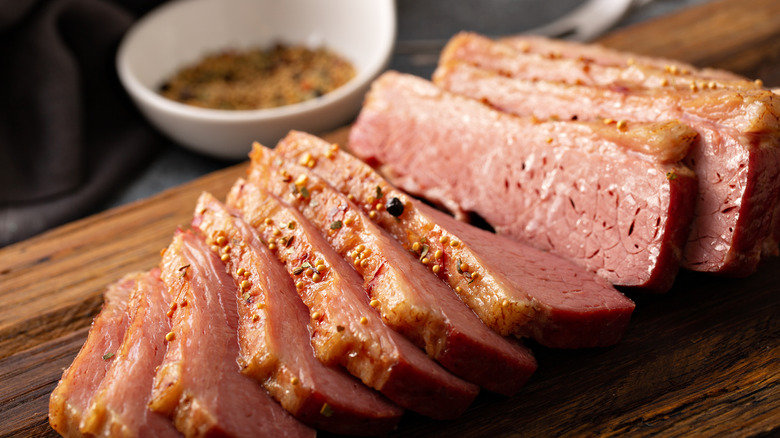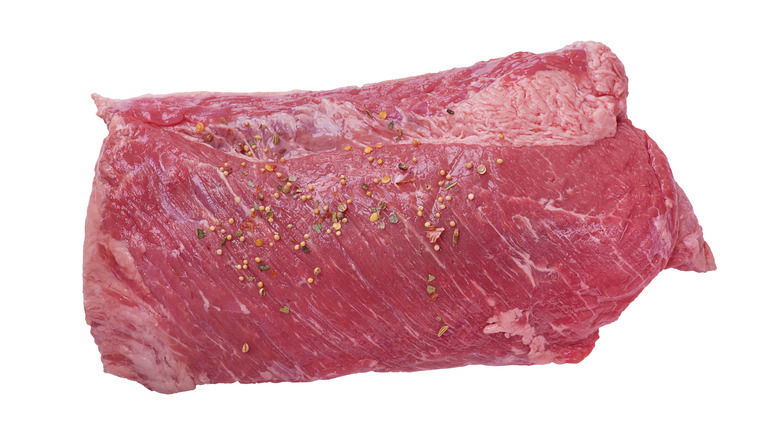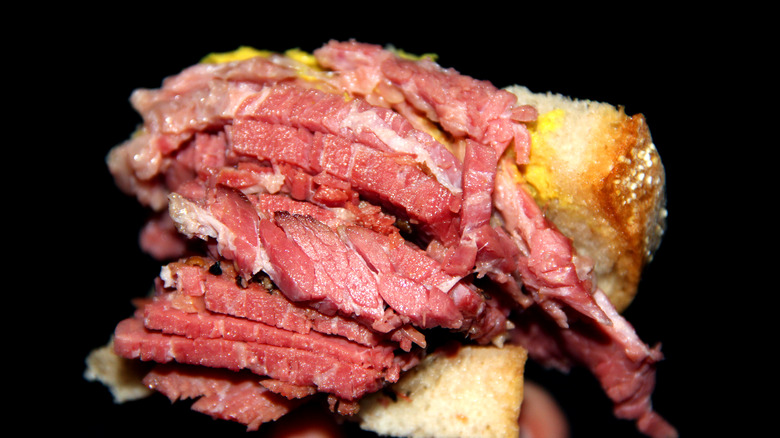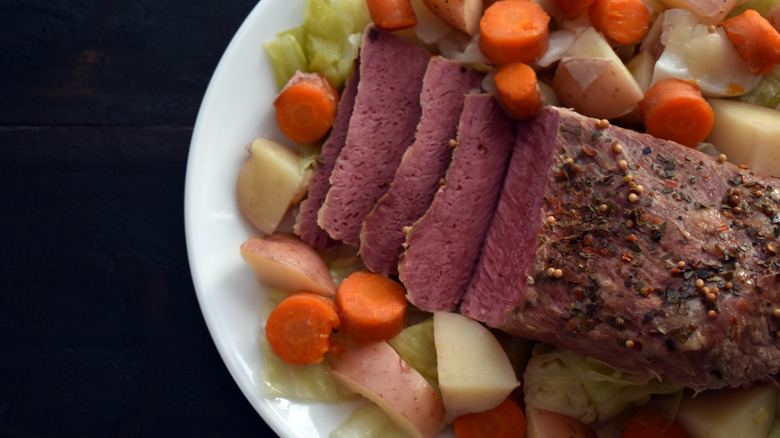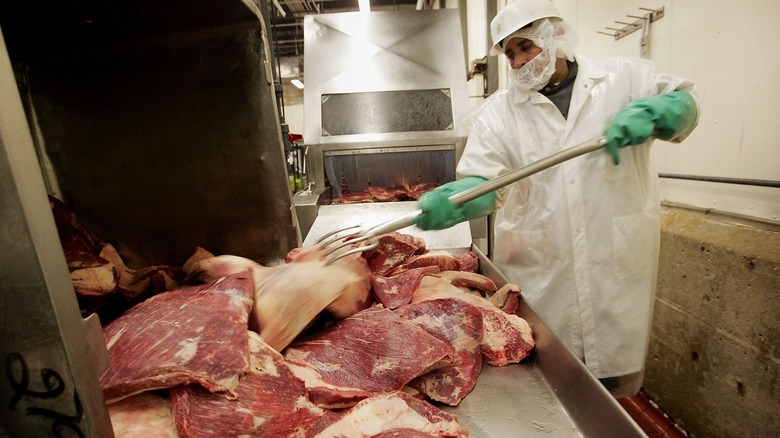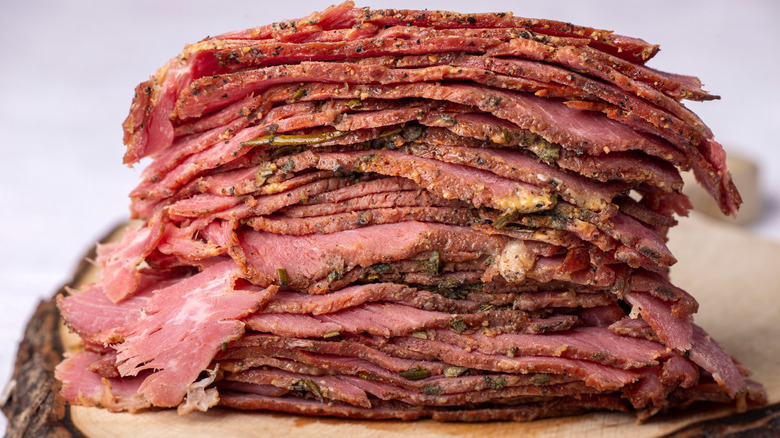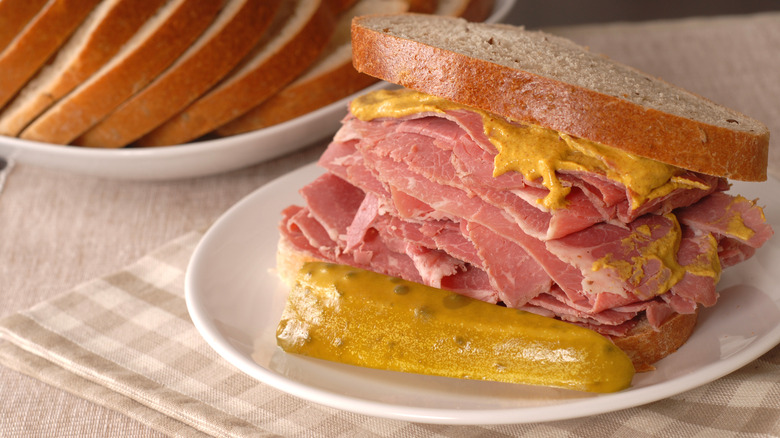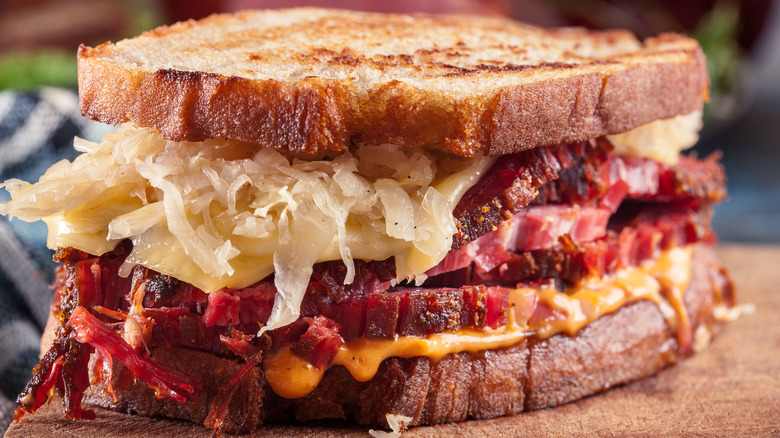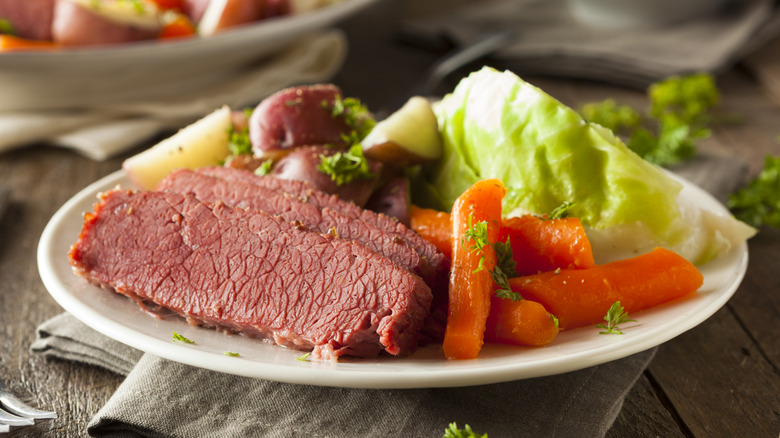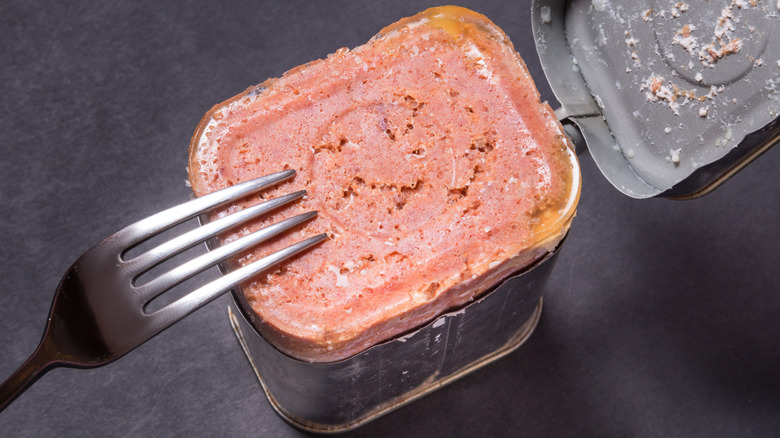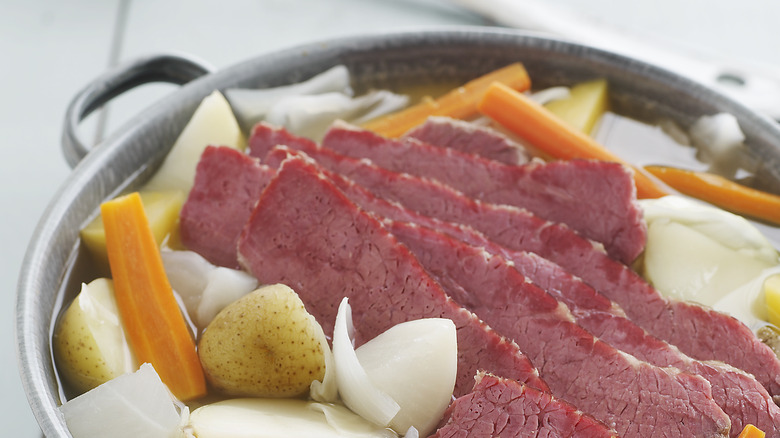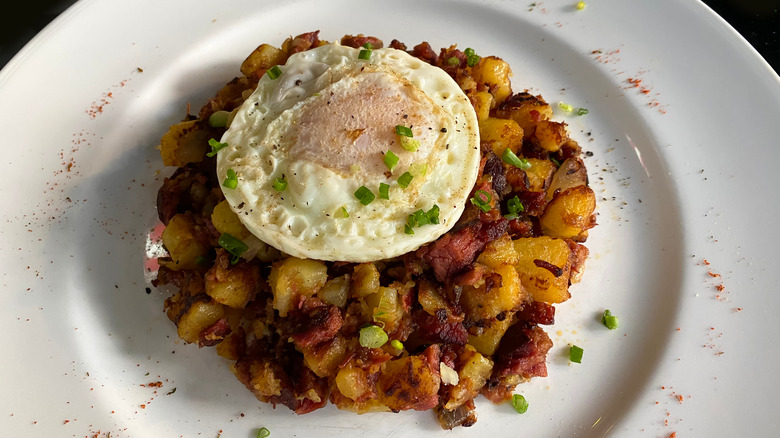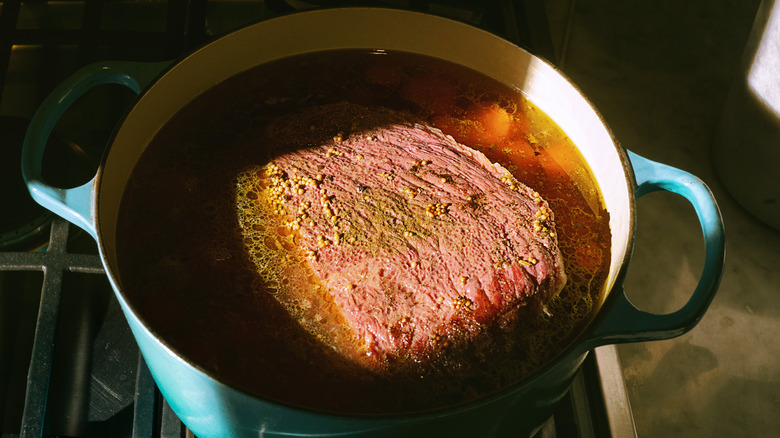12 Essential Corned Beef Tips For St. Patrick's Day And Beyond
Whether served up in towering piles on slices of rye bread at a deli or eaten with cabbage at a pub to soak up pints of Guinness on St. Patrick's Day, corned beef is undeniably popular. However, it's a meat that's frequently eaten at restaurants rather than prepared at home. If you're a corned beef fan who's intimidated by the idea of cooking it yourself, we're here to give you the lowdown on how to prepare delicious sandwiches, platters, hash, and more.
To help us help you, we've enlisted the expertise of Norm Langer, the second-generation owner of Langer's Delicatessen-Restaurant in Los Angeles. This venerable institution has been serving deli classics in the City of Angels since 1947. Norm has been there since the '60s, when he started working for his father Al, who founded the business. Not only does Langer's serve one of the best pastrami sandwiches in America, but the restaurant's menu is chock-full of corned beef prepared in a variety of ways. In an interview with Tasting Table, Norm Langer shared all of his corned beef secrets for your benefit.
1. There are different cuts of corned beef
According to Langer, one of the things that differentiates corned beef from other types of deli meat is the cut of beef that's used. Pastrami is made from the navel, which is close to a cow's ribs and is a fatty cut that's sort of like the beef version of pork belly. Corned beef is typically made with brisket, which is from the area near a cow's breastbone. Langer recommends buying a full-cut corned beef brisket (in other words, the whole brisket). This will give you multiple types of meat to choose from.
However, if you want to buy a smaller amount of corned beef, you can choose one of the two parts of the brisket: the point and the flat. The flat is preferable for corned beef, and sometimes corned beef is made with just the flat cut rather than a whole brisket. It is relatively lean and has a tight texture that's easy to cut, so it's perfect for creating deli sandwiches with clean, thin slices of meat. The point cut is fattier and less meaty, which makes it prone to falling apart. This is ideal for braised beef or shredded barbecue beef, but it's less desirable for corned beef.
2. Don't skimp on fat
Even if you choose corned beef made with the leaner flat end of the brisket, you want to make sure it has at least some fat on it. Per Langer, "All meat has to have a little bit of fat in order to boost the taste." One of the advantages of buying a whole brisket is that you have all the fat from the point to add flavor and moisture to the lean meat in the flat.
You may be tempted to ignore Langer's advice and opt for the leanest corned beef possible for health reasons, but if your goal is to eat flavorful beef, fat is king. A study in the journal Lipids in Health and Disease found that higher levels of intramuscular fat and fatty flavor in beef corresponded with more satisfaction from consumers. Fat is composed of many different fatty acid compounds that undergo chemical reactions during cooking, imparting crucial flavor notes to meat. Without fat, beef will lack the full spectrum of tastes you want.
Of course, the exact amount of fat you leave on your corned beef is up to you. If you prefer mostly meat, you can trim some of the fat away from your brisket. If, on the other hand, you want the richest, most decadent corned beef possible, go for the super-fatty cuts from the point.
3. You can corn your own beef
While most people think of corned beef as something to buy pre-made from the deli counter, you can cook corned beef at home from scratch. It's not simple, and it is time-consuming, but it is possible. To make corned beef, start with a big chunk of raw brisket and let it soak for nearly a week in a brine. Our recipe uses a ton of different spices and seasonings in the brine, including brown sugar, salt, pepper, coriander, mustard, bay leaves, juniper, allspice, and more. The most important ingredient in the brine, however, is pink curing salt (otherwise known as sodium nitrite).
Pink curing salt is not the same thing as Himalayan pink salt, which is naturally pink due to its trace mineral content. Curing salt is actually dyed pink so you don't accidentally mix it up with normal table salt. It sets the color of the meat, giving it the red/pink color you associate with corned beef. It also acts as a preservative.
Once your brisket has cured in its brine, it's now ready to cook, which you can do by simply boiling it for a few hours. If you're confident about your ability to safely cure meat at home, this might be a worthwhile weekend project for serious corned beef lovers.
4. But it might be best to leave it to the professionals
While it is technically possible to corn your own beef at home, our expert Norm Langer advises against it: "Processing meats with select herbs and spices should only done on a commercial basis in order to achieve perfection." That classic corned beef taste relies on a large number of seasonings working in harmony. If you make it at home and the balance of spices is just a little off, you might end up with some funky-tasting beef.
But beyond pure culinary concerns, there are also safety issues associated with curing meat in a home kitchen. According to the National Center for Home Food Preservation, germs like Clostridium botulinum, Clostridium perfringens, Listeria monocytogenes, and Staphylococcus aureus can all grow in improperly preserved meat. Many (though not all) of these pathogens can be killed by cooking or heating to a certain temperature, but even so, home curing is not a process to take lightly. Unless you have a firm handle on how much nitrite/nitrate and salt to use and are able to maintain a clean environment with the proper pH and temperature, it might be best to leave corned beef manufacturing to the professionals.
5. Corned beef is corned beef, no matter what you use it for
In America, corned beef is commonly found at two very different types of restaurants: Jewish delis and Irish pubs. At delis, the beef is generally served in sandwiches and sometimes in breakfast dishes, while pubs often serve boiled corned beef and cabbage plates. Sometimes there is crossover (for example, Langer's Deli serves both sandwiches and corned beef with cabbage), but overall, Jewish and Irish food traditions are fairly distinct from each other.
This might lead you to believe that deli corned beef and Irish corned beef are different products, but Norm Langer says they're exactly the same. In fact, corned beef and cabbage is an American creation that derives from the shared history of Irish and Jewish immigrants in New York City. Corned beef became a St. Patrick's Day tradition because Irish-Americans in Manhattan began buying the ingredient from Jewish butchers and using it in place of the salted pork that was more commonly eaten in Ireland. Ironically, although Ireland was historically a leading producer of corned beef, it was almost all manufactured for export and most Irish people couldn't afford to eat it. So while it might seem strange to buy Jewish deli-style corned beef for your St. Patrick's Day corned beef and cabbage, doing so is in keeping with the historical roots of the dish.
6. For sandwiches, make sure to pre-cook the corned beef
Although you can purchase pre-sliced processed corned beef from the supermarket deli counter that is fit to eat cold with no preparation, it's a poor substitute for the hot, juicy corned beef you'll find piled high on the sandwiches at your nearest traditional Jewish deli. For that, you'll have to buy a big chunk of corned beef brisket, and as Langer says, "Cook it until soft and tender." Then you'll have to slice it yourself. Let the beef rest for a bit after cooking so its juices don't run out, then slice with a carving knife against the grain to achieve the most tender texture — even perfectly-cooked corned beef can seem tough if you cut it with the grain. No matter how careful you are when cutting, some of the delicate meat will likely crumble away as you slice. Save the crumbles; we'll tell you what to do with those later.
Of course, the meat is only one component of a sandwich. To complete the dish, Langer advises you to "make sure you have rye bread that is properly seeded and baked. Add a little mustard to enhance the flavor." A lot of rye bread at the supermarket is a pale imitation of the real thing. You want something a little crusty and sharp, with plenty of caraway seeds. As for what mustard to choose, it's up to you, but for us, anything that's not spicy deli-style brown mustard feels wrong.
7. A perfect Reuben is all about construction
We've already given you the perfect formula for a classic corned beef sandwich, but if you want the ultimate corned beef experience, a Reuben might be the way to go. A classic Reuben sandwich recipe combines the salty, fatty richness of corned beef with acidity from sauerkraut, creaminess from melted Swiss cheese, and zest from Russian dressing (preferably homemade). This mound of goodness is generally served on two slices of griddled bread (rye is the only appropriate choice, of course).
Starting with the highest-quality ingredients you can find is the most important thing when making a Reuben at home, but proper sandwich construction can't be neglected either. As Langer puts it, "to make sure it is the best, make sure that you layer your products evenly, so the last bite is the same as the first." You don't want the middle of the sandwich to be a huge wad of toppings and the edges to be sad, dry crusts of bread. An even sandwich build will also help guard against mishaps — if the meat, kraut, and cheese are evenly distributed, it'll be less likely that fillings will leak out everywhere when you try to take a bite of your Reuben.
8. For corned beef and cabbage, cook the meat and vegetables separately
We should note that this isn't a hard-and-fast rule. Our recipe for crock pot corned beef has you cook the beef and vegetables together in the same slow cooker. There are advantages to doing it this way; it's simple and it uses very few dishes. However, Norm Langer prefers to cook his corned beef separately from his cabbage and wait to combine the meat and veg on the plate at the end. He says you can either boil or steam the cabbage.
Langer's method is arguably preferable to the one-pot technique for a couple of reasons. First, it gives you a lot of control over the cooking time of each component. Cabbage takes a lot less time to cook than corned beef does, and cooking it apart from the meat guards against overcooking. Second, you get more flavor contrast — the cabbage taste like cabbage and the beef tastes like beef. With only one pot, everything ends up tasting like corned beef, which you may or may not enjoy.
9. Stay away from canned corned beef for corned beef and cabbage
There's an exception to the "all corned beef is the same" rule: canned corned beef. Instead of being made with brisket, the canned stuff is usually an assemblage of mystery cuts of beef chopped so finely they turn into a kind of beef mush. (It probably comes as no surprise that it earned a spot on our list of the worst canned foods.) Canned corned beef lacks the flavor complexity of the real stuff as well. Instead of the intricate mix of spices and herbs used for deli corned beef, the canned variety is preserved with just sugar, salt, and sodium nitrite.
Canned corned beef's pasty texture makes it unsuitable for corned beef and cabbage; you can't boil it without it just falling apart. You can make a sandwich with canned corned beef, but it won't be the piled-high meat mountain of your dreams. The product is so salty that it works best as a thin spread on bread. Corned beef hash tastes okay when made with canned corned beef, but it's still better with the non-canned variety. If you're stocking your emergency bunker and need a convenient protein source, canned corned beef might do the job, but for most normal applications, deli-style corned beef made from a whole brisket is superior.
10. Corned beef takes a long time to cook perfectly
If you're planning on making a tasty corned beef dinner, be prepared to set aside a large part of your day — and start cooking well before dinnertime. The beef must be boiled for a long time before it becomes tender, and there's a lot of variation in how long it will take depending on the specifics of your cut of beef. Langer estimates that it takes 2 to 5 hours of boiling to properly cook a corned beef brisket.
Why the long cooking time? It's because of the cut of meat corned beef is made from. Brisket is incredibly rich in collagen, a type of connective tissue. This makes it a super-tough piece of meat when fresh. In order to melt the collagen and tenderize the beef, brisket needs to cook for a very long time. The advantage of having all that connective tissue is that once brisket is cooked enough to become soft, it develops a silky, luscious, unctuous texture that other cuts of beef just don't have.
11. Corned beef hash is the best way to use leftovers
Remember all those crumbles from slicing corned beef that we mentioned earlier? Don't throw them away; save them, along with any other corned beef trim, to create one of the ultimate diner breakfasts: corned beef hash.
If you've only ever had the corned beef hash from a can that looks and smells like dog food, the fresh stuff made from scratch will be a revelation. Langer likes to mix his corned beef leftovers with onions, spices, and potatoes, but you can feel free to play around with ingredients you enjoy. Our corned beef hash recipe uses herbs and a little lemon to add freshness to what can be a rather heavy dish. Just fry everything together in a skillet to give it a crisp texture, serve with some eggs and toast, and you have a breakfast fit for royalty.
Hash is just one way to eat corned beef for breakfast. At Langer's, you can also find the meat tucked inside omelets and served with egg breakfasts in place of sausage or bacon. If you're looking to switch up your breakfast routine or don't eat pork, corned beef might be the perfect breakfast meat for you.
12. Don't cover up your corned beef with other flavors when you cook it
Real corned beef is a beautiful product made with care. The manufacturing process involves a delicate blend of herbs and spices, and the last thing you want to do when you're preparing it is to mess with perfection by adding too many other flavors to the party. That's why Norm Langer advocates a minimalist approach to preparing corned beef. "Corned beef should be boiled in plain water," he notes. "Do not add anything to it, as it will work against the brining that the meat has already experienced."
Unlike with blander meats like fresh beef or chicken, this kind of simple, plain cooking technique won't leave you with a disappointing result — corned beef is flavorful enough to stand on its own. In fact, by getting too fancy, you'll probably detract from the quality of the meat and make it worse. Ancho-lime corned beef might sound like a mashup made in heaven in your head, but in practice, it's most likely not going to win many fans.
Static Media owns and operates Tasting Table and Mashed.
